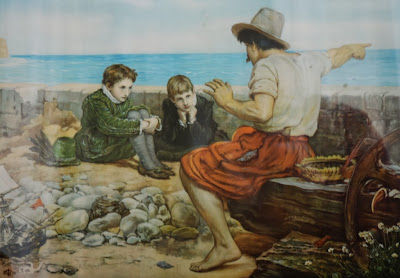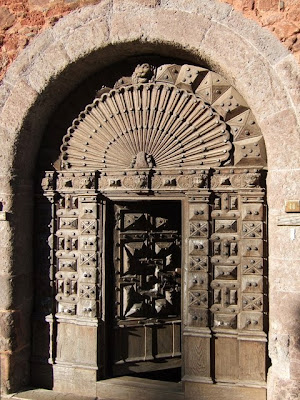Gloriana’s West Country on show
The Boyhood of Raleigh is one of the Pre-Raphaelite artist Sir John Millais’ most celebrated works, painted during his stay in Budleigh Salterton in 1870
With the quatercentenary of Sir Walter Raleigh’s death only four years away you could guess that at least one Fairlynch volunteer might be recalling the famous years of 2000 and even 1969. Those two high points in the Museum’s history were reached when Sir John Millais’ celebrated depiction of East Budleigh’s best known personality went on show. To greet the arrival of ‘The Boyhood of Raleigh’ at Fairlynch in July 1969 three members of the US Marine Detachment from its 6th Fleet HQ in London’s Grosvenor Square joined forces with three Royal Marines from Lympstone to stand guard over the painting, a military band played and Tudormania broke out. Visitor numbers at the Museum shot up. For the management of such a small institution as Fairlynch it was an amazing achievement.
‘West Country to World’s End - The South West in the Tudor Age’ is the current exhibition at Exeter’s Royal Albert Memorial Museum & Art Gallery, better known to locals as RAMM. Exhibitions about this period usually focus on London, as pointed out by Prof Sam Smiles in the introduction to the book of the same title accompanying the exhibition. So it’s only right that the West Country should be spotlighted for the rich contribution that it made to the arts and crafts of the English Renaissance.
In Exeter itself Tudor landmarks like the Guildhall, seen above, survived the destruction wrought by German air raids and city planners. They testify to the wealth of the city’s merchants, many of whom were involved in the cloth trade.
As far as the role of the city planners is concerned, another worthwhile
online resource to look at is the ‘Demolition Exeter’ site by fellow-blogger
Wolfpaw, showing how much of the city’s heritage has been lost for ever. The
pages dealing with the demolition of 38
North Street with its magnificent plaster ceiling
are especially telling. Click on
http://demolition-exeter.blogspot.co.uk/2010/11/no-38-north-street.html to see what I mean. Fragments of the ceiling
are on display in the RAMM exhibition.
Equally associated with the cloth trade and happily another visitor attraction which has survived in today’s Exeter was St Nicholas Priory, pictured above, the home of the wealthy Hurst family between around 1575 and 1602.
The two jewellery shops in Goldsmith Street, just off the city’s High Street, serve as reminders of one of Exeter’s traditional crafts
The RAMM exhibition has some beautiful examples of elaborately
worked gold and silver ware: Exeter
alone boasted 23 goldsmiths in the 16th century. I didn’t know about the importance of spoons
for Tudor people.
The 'Exeter Salt' c. 1580
Image credit: http://artsconnected.org/resource/printImage/5058
Having
set up the 2013 Fairlynch Museum exhibition ‘Sea Salt and Sponges’ which
included a section on salt-making in the Budleigh Salterton area, I was interested
in this image of the so-called ‘Exeter Salt’ made by city goldsmith Christopher Eston in
around 1580, now in the Minneapolis Institute of Arts
Not to be confused with the equally stunning ‘Exeter Salt’ made by
the 17th century Johann Hass in around 1630, presented to Charles II by the
city of Exeter and now in the Royal Collection. Click on http://www.royalcollection.org.uk/collection/31772/the-exeter-salt to see it.
Benvenuto Cellini's extravagant salt cellar
Image credit: Jerzy
Strzelecki
Had I known about them I would have used these examples rather
than the 'saliera' shown above made by Cellini for the French king Francis I. But that’s
pretty spectacular as well. And of course the Italian sculptor’s masterpiece
was also a fine example of sophisticated workmanship of the Tudor period.
The oak door of No 10 Cathedral Close, Exeter. Image credit Derek Harper
Sadly for Budleigh people as I pointed
out at http://budleighbrewsterunited.blogspot.co.uk/2013/12/red-man-or-green-man.html there is no mention of the All Saints
Church carved oak bench ends in the exhibition. On display instead are the
rather more sophisticated and later oak doors from Exeter High School
attributed to craftsman Nicholas Baggett, similar in style to the door of No 10
Cathedral Close. Baggett’s work can also be seen at the city’s Guildhall.
However many of our Fairlynch volunteers will admire the
mid-17th century bone lace collar and two cuffs from the Victoria
& Albert Museum which are on display in the RAMM
exhibition.
The RAMM exhibition includes a number of these miniatures, with
magnifying glasses thoughtfully provided by the curators. Other larger and often striking paintings are
on display, ranging from Joan Tuckfield, the widow of an Exeter cloth merchant, to Queen Elizabeth
herself. More portraits of Tudor personalities include those of John Russell,
Earl of Bedford and Lord Lieutenant of Devon (1485-1555) by Hans Holbein the
Younger, Sir George Carew (c.1504-1545), the naval commander who drowned when
his flagship the Mary Rose sank during the Battle of the Solent; Sir Richard
Grenville (1542-1591) and Sir Francis Drake (c. 1540-1596); and the antiquaries
John Hooker (c.1527-1601) and Richard Carew (1555-1620).
Budleigh people will admire the life size portrait of Raleigh and
his son in the exhibition. But I wondered why, unlike the portrait of Sir Francis Drake also on
display, it’s not accompanied by a heading and more detailed biographical text. The
little detail of Wat’s death in 1618 during Raleigh’s
last and fateful expedition to the Indies could have been mentioned, along with the story of the suicide of Raleigh’s commander
Lawrence Kemys. Seemingly overcome by remorse and feeling responsible for the
young man’s death he first shot himself before plunging a knife into his heart:
events which were sad precursors of Raleigh’s
own death on the scaffold nine months later. And perhaps this corner of the exhibition
should have been where a copy of Sir Walter’s History of the World should have
been displayed. Published in 1614 it’s on loan from Exeter Cathedral Library.
Drake deserves the attention he receives in the RAMM exhibition,
not just for his circumnavigation of the globe but for his role in the defeat
of the Spanish Armada to which a section of the Exeter exhibition is devoted. On loan from the Worshipful Company of
Apothecaries is a stylised depiction of
key elements of the Armada story: the alarm beacons, Queen Elizabeth at
Tilbury, and the sea battle at Gravelines. It is viewable at http://en.wikipedia.org/wiki/Spanish_Armada
 This 19th century illustration by the American Henry
Howe shows John White and his family at the baptism of his grand-daughter
Virginia Dare, named thus “because this childe was the first Christian borne in
Virginia.” It comes from the book by William A. Crafts Pioneers
in the settlement of America:
from Florida in 1510 to California
in 1849, Boston
1876.
This 19th century illustration by the American Henry
Howe shows John White and his family at the baptism of his grand-daughter
Virginia Dare, named thus “because this childe was the first Christian borne in
Virginia.” It comes from the book by William A. Crafts Pioneers
in the settlement of America:
from Florida in 1510 to California
in 1849, Boston
1876.
RAMM is a fine museum for the vibrant and historic city of Exeter and ‘West Country to World’s End’ will inspire me
to learn more about the age of the Tudors in this part of England.
I’ve still not taken a Red Coat tour after six years of living
within easy reach of the city. Click on http://www.exeter.gov.uk/index.aspx?articleid=668 to find out more.
 Maybe a Red Coat guide can tell me about Mr John Palmer, mentioned in this
inscription at the almshouse which he endowed on Magdalen Street. Maybe he too should
have been featured in the exhibition at RAMM.
Maybe a Red Coat guide can tell me about Mr John Palmer, mentioned in this
inscription at the almshouse which he endowed on Magdalen Street. Maybe he too should
have been featured in the exhibition at RAMM.
A visit to the vast expanses of the Exeter museum inevitably brings home the
contrast with quirky little Fairlynch so I could not understand why some of the
exhibit notices were placed at a child’s level. And it’s such a fine exhibition
that you might expect to see more publicity given to it at the Museum’s
entrance, with instructions on how to find it. But these are quibbles.
A sketch for the arms and crest granted to John Hawkins, 'Canton geven by Rob[er]t Cooke Clar[enceux] King of Arms 1568'. The bound African slave on the crest reflects the trade that Hawkins pioneered.
Image credit: www.nationalarchives.gov.uk by
permission of The College of Heralds, London
(1568)
Not such a quibble - and an omission which has caused disquiet
among some visitors and correspondence in the local press - is the absence of
any mention that one of Gloriana’s Devon heroes was the nation’s first slave
trader. The role of Admiral Sir
John Hawkins (1532–1595) as the
Englishman who founded the triangular slave trade means that Plymouth will always be inextricably linked
with this most inhumane of practices,
admits its City Council.
Click on http://www.plymouth.gov.uk/homepage/leisureandtourism/libraries/history/historyroom/slaveryandabolition/johnhawkins.htm
to read more. Inhumane? Yes, but no
more so than the wars and cruelties of the past, including religious persecution
and public executions, that sit so uneasily with the Renaissance tradition of
courtliness, scholarship and artistic splendour.
 Hawkins’
notoriety as a slaver is mentioned in the book to accompany the exhibition, but
perhaps a reminder could have been found for the exhibition itself. Slave chains like these are among RAMM’s many
artefacts.
Hawkins’
notoriety as a slaver is mentioned in the book to accompany the exhibition, but
perhaps a reminder could have been found for the exhibition itself. Slave chains like these are among RAMM’s many
artefacts.
Admittedly from a much later
period they could have served as a guilt-assuaging reminder that Devon people like the Exeter-born
missionary Henry Townsend (1815-1886) were among those went out to Africa with
the intention of helping its people rather than enslaving them. Click on http://www.rammuseum.org.uk/collections/collectors/henry-townsend-1820-1885 and on
http://www.dacb.org/stories/nigeria/townsend_henry.html to read a much fuller biography.
‘West Country to
World’s End - The South West in the Tudor Age’ continues until 2 March 2014 For
more details click on http://www.rammuseum.org.uk/













Comments
Post a Comment